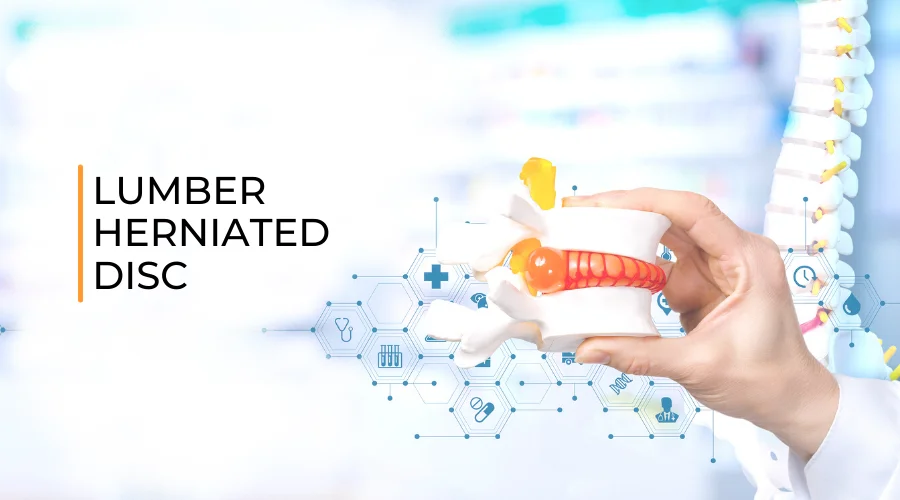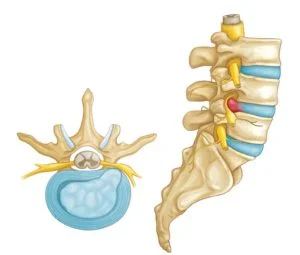Lumber Herniated Disc
Home / Lumber Herniated DiscLumber Herniated Disc Treatment in Delhi

A herniated disk refers to a problem with one of the rubbery cushions (disks) between the individual bones (vertebrae) that stack up to make your spine.
A spinal disk is a little like a jelly donut, with a softer center encased within a tougher exterior. Sometimes called a slipped disk or a ruptured disk, a herniated disk occurs when some of the softer “jelly” pushes out through a crack in the tougher exterior.
A herniated disk can irritate nearby nerves and result in pain, numbness or weakness in an arm or leg. On the other hand, many people experience no symptoms from a herniated disk. Most people who have a herniated disk don’t need surgery to correct the problem.
Symptoms
 You can have a herniated disk without knowing it — herniated disks sometimes show up on spinal images of people who have no symptoms of a disk problem. But some herniated disks can be painful. Most herniated disks occur in your lower back (lumbar spine), although they can also occur in your neck (cervical spine).
You can have a herniated disk without knowing it — herniated disks sometimes show up on spinal images of people who have no symptoms of a disk problem. But some herniated disks can be painful. Most herniated disks occur in your lower back (lumbar spine), although they can also occur in your neck (cervical spine).
The most common signs and symptoms of a herniated disk are:
- Arm or leg pain. If your herniated disk is in your lower back, you’ll typically feel the most intense pain in your buttocks, thigh and calf. It may also involve part of the foot. If your herniated disk is in your neck, the pain will typically be most intense in the shoulder and arm. This pain may shoot into your arm or leg when you cough, sneeze or move your spine into certain positions.
- Numbness or tingling. People who have a herniated disk often experience numbness or tingling in the body part served by the affected nerves.
- Weakness. Muscles served by the affected nerves tend to weaken. This may cause you to stumble, or impair your ability to lift or hold items.
Causes
Disk herniation is most often the result of a gradual, aging-related wear and tear called disk degeneration. As you age, your spinal disks lose some of their water content. That makes them less flexible and more prone to tearing or rupturing with even a minor strain or twist.
Most people can’t pinpoint the exact cause of their herniated disk. Sometimes, using your back muscles instead of your leg and thigh muscles to lift large, heavy objects can lead to a herniated disk, as can twisting and turning while lifting. Rarely, a traumatic event such as a fall or a blow to the back can cause a herniated disk.
Risk Factors
Factors that increase your risk of a herniated disk may include:
- Weight. Excess body weight causes extra stress on the disks in your lower back.
- Occupation. People with physically demanding jobs have a greater risk of back problems. Repetitive lifting, pulling, pushing, bending sideways and twisting also may increase your risk of a herniated disk.
- Genetics. Some people inherit a predisposition to developing a herniated disk.
Complication
Your spinal cord doesn’t extend into the lower portion of your spinal canal. Just below your waist, the spinal cord separates into a group of long nerve roots (cauda equina) that resemble a horse’s tail. Rarely, disk herniation can compress the entire cauda equina. Emergency surgery may be required to avoid permanent weakness or paralysis.
Seek emergency medical attention if you have:
- Worsening symptoms. Pain, numbness or weakness may increase to the point that you can’t perform your usual daily activities.
- Bladder or bowel dysfunction. People who have the cauda equina syndrome may become incontinent or have difficulty urinating even with a full bladder.
- Saddle anesthesia. This progressive loss of sensation affects the areas that would touch a saddle — the inner thighs, back of legs and the area around the rectum.
Prevention
To help prevent a herniated disc:
- Exercise. Strengthening the trunk muscles helps stabilize and support the spine.
- Maintain good posture. Good posture reduces the pressure on your spine and disks. Keep your back straight and aligned, particularly when sitting for
- long periods. Lift heavy objects properly, making your legs — not your back — do most of the work.
Maintain a healthy weight. Excess weight puts more pressure on the spine and discs, making them more susceptible to herniation.
Physiotherapy Treatment
Physiotherapy plays a very important role in the treatment of lumbar disc herniation. Most of the patients recover without a surgery. Hence it is advisable to consider conservative treatment like physiotherapy before going for a surgery. Studies have shown that patients present similar symptoms two years post surgery hence your doctor will recommend physiotherapy before any invasive treatment.
Physiotherapy is considered a choice of treatment because;
- Provides immediate pain relief.
- Improves mobility.
- Improves posture.
- Improves flexibility.
- Improves strength.
- Prevents further damage.
Home programme management is also on the above lines and also on the correction of body mechanics to avoid further damage to the spine and adjoining soft tissues.
When a person with lumbar herniation symptoms comes to us at Delhi Physio Care his history is taken and then he is examined. The physiotherapist will then plan an individualized treatment programme aimed at providing pain relief and improving mobility.
Various modalities options are available in the initial recovery phase for pain relief. We generally make a combination of two to three modalities depending on the symptoms. These could be hot\cold packs, TENS, laser therapy, ultrasound therapy, and electrotherapy. Other than these… deep soft tissue mobilization, manual tractions (reduces neurological symptoms), vertebral mobilization are recommended.
At times exercises are not advised in the initial recovery phase if the pain is too severe and a couple of days of bed rest with a lumbar support may be suggested (1-2 days). The exercises are programmed at starting gradually and then progressed. Exercises are aimed at;
- To improve core stability(supports spine).
- Improving flexibility.
- Improve the strength of the spinal muscles.
- Correct the posture.
- To help you do the daily activities better in a pain-free way. Other than these various stretches are taught.
Exercises improves the strength and flexibility and also reduces the risk of further damage (herniation), if done religiously and regularly but they cannot and should not be done without the supervision of your physiotherapist. The progression and which exercise to do when is very important.
IMPORTANT TIP: if any particular exercise is painful while doing it or after you have done it. Stop doing it and bring it to the notice of your therapist. Your physio will always progress your exercises monitoring your recovery and add 2-3 exercises every day.
Lumbar disc herniation recovery can take 2-8 weeks depending on the severity.
LEARN TO EXERCISE WELL!! Pay attention and focus on the movements. Put your mind and energy in what you are doing. These would be your home management and long term goals to stay pain free, active and healthy.
SIMPLE EXERCISES FOR BACK MUSCLE STRENGTHENING
QUICK ENQUIRY
Send us a message with your contact details and one of our staff will contact you right away.
TREATMENTS
BOOK AN APPOINTMENT
GENERAL ENQUIRIES
235, Avtar Enclave,Paschim Vihar,Delhi – 110063
Lumber Herniated Disc FAQ’s
Herniated discs cause significant pain and dysfunction. It is a common disc injury caused due to obesity, chronic injury, or some other problem.
90% of the herniated disc injuries can be treated with Physiotherapy. Surgery may be required to repair herniated discs in extreme cases where there is a risk of total disability.
A herniated disk can be attributed to different factors. Any serious injury or strain affecting the back can lead to a herniated disk. Weakening of the disk due to constant degeneration can also cause the disk to rupture.
Yes, herniated disks can cause discomfort and pain. A person with herniated disk can experience pain in the back, hip, stiffness in the legs. Sometimes the pain is too strong to bear.
Herniated disk problems can be treated by expert physiotherapy sessions. In physiotherapy, there are specialized methods to reduce the pain and heal the herniated disk without any surgery.
It is quite common to have more than one herniated disc. Single or multiple herniated discs can occur in the lumbar spine of anyone.
The common symptoms of a Herniated discs are as below:
– numbness in legs or fingers
– back pain
– neck pain
– spasm and muscle pain
